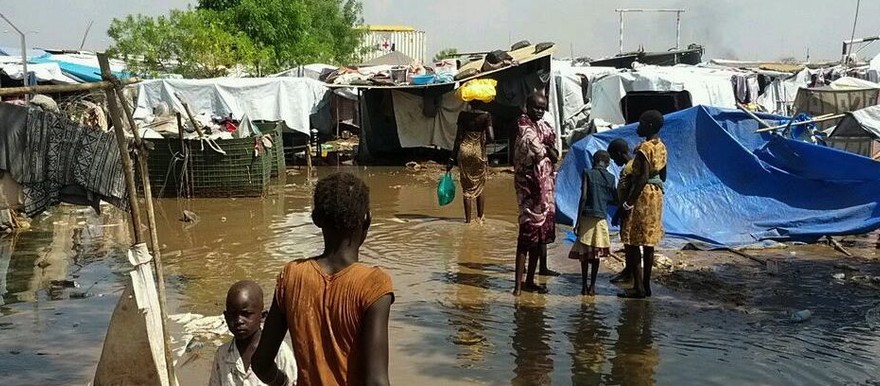Rain fell on Juba tonight for the third time since Friday, marking the start of South Sudan’s protracted annual rainy season and swamping crowded camp areas sheltering approximately 45,000 people.
As rains become more frequent and heavier later in March and April, roads across the country are expected to become increasingly impassable, while living conditions at the overcrowded bases where tens of thousands of people are sheltering in fear of their lives are expected to deteriorate rapidly.
“Early rains in Juba caused flooding in the UN Tomping displacement site, destroying hundreds of shelters and exacerbating already difficult living conditions,” the United Nations reported on Monday in a regular briefing by the Officer for Coordination of Humanitarian Affairs (OCHA).
The Tongping site along with the UN House site host about 45,000 people, mostly ethnic Nuers, and are defended by UN peacekeepers. During the first heavy rains on 7 March, more than 640 shelters were destroyed in Tongping and the shelters of more than 8,700 individuals flooded, according to OCHA.
According to the latest briefing published by OCHA on Monday, aid agencies intend to start transferring people from plots in Tongping to available ones at the UN House base on the other side of the city. But rains tonight at UN House have reportedly caused flooding there as well.
OCHA says the floods give a sense of the ‘challenges’ that the displaced communities will face once the rainy season starts in earnest in April.
Tongping was also the site of a recent measles outbreak, and emergency health providers are concerned about cases of acute watery diarrhea, though data on the matter has not yet been published.
Elsewhere in South Sudan, severe access constraints continued to be the largest problem faced by aid agencies in responding to the humanitarian crisis, in particular in Unity State, the most heavily affected state in terms of displacement, with about a third of the population on the run.
The UN acknowledged in its latest update, “the state remained one of the main gaps in the humanitarian response, with access to displaced people in Leer and Koch still severely constrained by insecurity, and limited partner capacity in other parts of the state.”
Aid agencies are working in Bentiu town, Pariang County, and in Ganyiel in Panyijar County. But concerns about land mines, ambushes on convoys, and increased checkpoints run by security forces have cut off most of the nearly 200,000 displaced people in the state from access to any kind of humanitarian assistance whatsoever.
Similar constraints are faced by humanitarian workers in Jonglei, a state where control is divided between opposition to the north and government forces to the south.
During the last week, however, the UN-led logistics cluster facilitated the airlift of 54 tonnes (24 flights) of “lifesaving supplies on behalf of ten humanitarian organizations to Akobo, Ajoung Thok, Malakal, Rubkona and Waat,” OCHA reported.
Malnutrition screening in one of those areas, Akobo, was carried out with a finding of about 50% of children malnourished. Out of 5,403 children under five years screened, 504 were “severely malnourished” and 2,424 were “moderately malnourished.”
Related coverage:
Displaced at UN base in Juba: ‘We’re not leaving’ (28 Feb.)
Key humanitarian update: Water shortage at UN Malakal base (1 March)
Photo: Civilians wade through water after hours of rain at UNMISS Tongping, 10 March 2014 (UN/Toby Lanzer)




